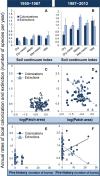The pace of plant community change is accelerating in remnant prairies
- PMID: 26989775
- PMCID: PMC4788480
- DOI: 10.1126/sciadv.1500975
The pace of plant community change is accelerating in remnant prairies
Abstract
Patterns of biodiversity are changing rapidly. "Legacy studies" use historical data to document changes between past and present communities, revealing long-term trends that can often be linked to particular drivers of ecological change. However, a single pair of historical samples cannot ascertain whether rates of change are consistent or whether the impact and identity of drivers have shifted. Using data from a second resurvey of 47 Wisconsin prairie remnants, we show that the pace of community change has increased with shifts in the strength of particular drivers. Annual rates of local colonization and extinction accelerated by 129 and 214%, respectively, between 1950 and 1987 and between 1987 and 2012. Two anthropogenic drivers-patch area and fire history-increased in importance between these periods. As the strength and number of anthropogenic forces increase, rates of biodiversity change are likely to accelerate in other ecosystems as well.
Keywords: Biodiversity; ecological communities; ecological diversity; ecology; environmental sciences; novelty; plant communities.
Figures



References
-
- Estes J. A., Terborgh J., Brashares J. S., Power M. E., Berger J., Bond W. J., Carpenter S. R., Essington T. E., Holt R. D., Jackson J. B. C., Marquis R. J., Oksanen L., Oksanen T., Paine R. T., Pikitch E. K., Ripple W. J., Sandin S. A., Scheffer M., Schoener T. W., Shurin J. B., Sinclair A. R. E., Soulé M. E., Virtanen R., Wardle D. A., Trophic downgrading of planet Earth. Science 333, 301–306 (2011). - PubMed
-
- Vitousek P. M., Mooney H. A., Lubchenco J., Melillo J. M., Human domination of Earth’s ecosystems. Science 277, 494–499 (1997).
-
- Smith M. D., Knapp A. K., Collins S. L., A framework for assessing ecosystem dynamics in response to chronic resource alterations induced by global change. Ecology 90, 3279–3289 (2009). - PubMed
-
- Vellend M., Brown C. D., Kharouba H. M., McCune J. L., Myers-Smith I. H., Historical ecology: Using unconventional data sources to test for effects of global environmental change. Am. J. Bot. 100, 1294–1305 (2013). - PubMed
Publication types
MeSH terms
LinkOut - more resources
Full Text Sources
Other Literature Sources
Research Materials
Miscellaneous

